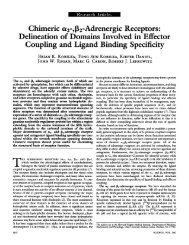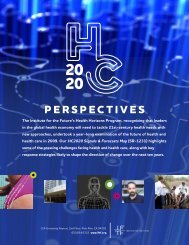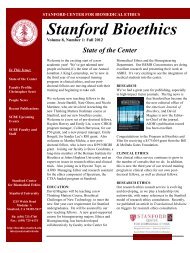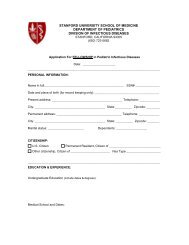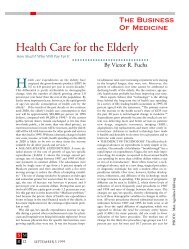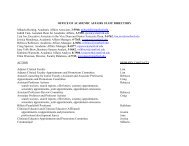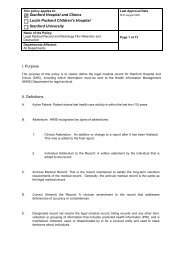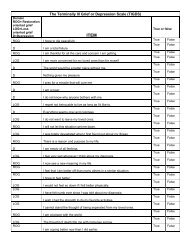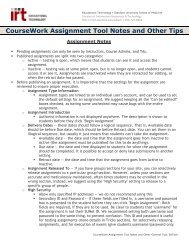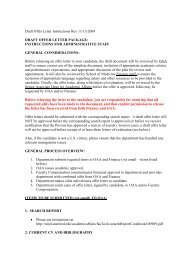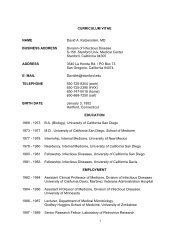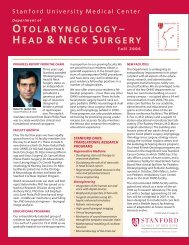MASTER OF SCIENCE - Stanford University School of Medicine
MASTER OF SCIENCE - Stanford University School of Medicine
MASTER OF SCIENCE - Stanford University School of Medicine
Create successful ePaper yourself
Turn your PDF publications into a flip-book with our unique Google optimized e-Paper software.
<strong>MASTER</strong> <strong>OF</strong> <strong>SCIENCE</strong><br />
G R A D U A T E PROGRAM IN<br />
E P I D E M I O L O G Y<br />
STANFORD UNIVERSITY<br />
Information and Guidelines
2008 EPIDEMIOLOGY GRADUATES (MARCH AND JUNE) AND CURRENT POSITIONS<br />
Gaurav Arora, MD, MS Fellow, Gastroenterology, <strong>University</strong> <strong>of</strong> Texas at Houston<br />
Jose Bazan, MD, MS Intern, Internal <strong>Medicine</strong>, Kaiser Permanente, Santa Clara<br />
Alicia Gutierrez, MS Research assistant, Pediatrics (Infectious Diseases), <strong>Stanford</strong><br />
Joyce Hsu, MD, MS Instructor, Pediatrics (Rheumatology), <strong>Stanford</strong><br />
Maarten Lansberg, MD, PhD, MS Assistant Pr<strong>of</strong>essor, Neurology & Neurological Sciences, <strong>Stanford</strong><br />
Jennifer Lee, MD, PhD Assistant Pr<strong>of</strong>essor, <strong>Medicine</strong> (Endocrinology, Clinical Nutrition, & Vascular <strong>Medicine</strong>),<br />
<strong>University</strong> <strong>of</strong> California at Davis<br />
Kari-Jean McKenzie, MS Medical student, <strong>University</strong> <strong>of</strong> British Columbia<br />
Chirag Patil, MD, MS Senior resident, Neurosurgery, <strong>Stanford</strong><br />
Mohammad Subeh, MS Medical student, Oregon Health and Science <strong>University</strong><br />
2007 EPIDEMIOLOGY GRADUATES AND CURRENT POSITIONS<br />
Sally Arai, MD, MS Assistant Pr<strong>of</strong>essor, <strong>Medicine</strong> (Blood & Marrow Transplantation), <strong>Stanford</strong><br />
Megan Bowles, MD, MS Practice <strong>of</strong> family medicine<br />
Ian Carroll, MD, MS Clinical Instructor, Anesthesiology (Pain Management), <strong>Stanford</strong><br />
Lawrence Chu, MD, MS Clinical Assistant Pr<strong>of</strong>essor, Anesthesiology, <strong>Stanford</strong><br />
Chrysoula Dosiou, MD, MS Clinical Assistant Pr<strong>of</strong>essor, <strong>Medicine</strong> (Endocrinology, Gerontology & Metabolism), <strong>Stanford</strong><br />
Gregory Engel, MD, MS Practice <strong>of</strong> cardiology<br />
Susan Hintz, MD, MS Associate Pr<strong>of</strong>essor, Pediatrics (Neonatology), <strong>Stanford</strong><br />
Andrew Jaciw, MS Doctoral student, <strong>School</strong> <strong>of</strong> Education, <strong>Stanford</strong><br />
Seble Kassaye, MD, MS Fellow, Infectious Diseases, <strong>Stanford</strong><br />
Ahmad Kamal, MD, MS Practice <strong>of</strong> gastroenterology<br />
Sue Kim, MD, MS Practice <strong>of</strong> internal medicine, Kaiser Permanente, Santa Clara<br />
Allison Kurian, MD, MS Assistant Pr<strong>of</strong>essor, <strong>Medicine</strong> (Oncology), and Health Research & Policy (Epidemiology),<br />
<strong>Stanford</strong><br />
Cynthia Leung, MD, MS Fellow, Gastroenterology & Hepatology, <strong>Stanford</strong><br />
Henry Lee, MD, MS Clinical Assistant Pr<strong>of</strong>essor, Pediatrics (Neonatology), <strong>University</strong> <strong>of</strong> California at San Francisco<br />
Rebecca Newton Thompson, MD, MS Chief Resident, Family <strong>Medicine</strong>, Oregon Health and Science <strong>University</strong><br />
Robin Varghese, MD, MS Fellow, Critical Care, <strong>University</strong> <strong>of</strong> Western Ontario<br />
Christine Won, MD, MS Clinical Assistant Pr<strong>of</strong>essor, <strong>Medicine</strong> (Pulmonary & Critical Care), <strong>University</strong> <strong>of</strong> California at<br />
San Francisco<br />
Information in this document is intended as a guide for students<br />
and is subject to change without notice.<br />
For further information please contact<br />
Educational Coordinator<br />
Department <strong>of</strong> Health Research and Policy<br />
<strong>Stanford</strong> <strong>University</strong> <strong>School</strong> <strong>of</strong> <strong>Medicine</strong><br />
<strong>Stanford</strong>, CA 94305-5405<br />
Phone: (650) 723-5456<br />
E-mail: epiprogram@med.stanford.edu<br />
Printed September 2008 (111708)<br />
Back cover: L.A. Cicero / <strong>Stanford</strong> News Service. Other photos provided by V. Henderson, K. Horner, J. Parsonnet, R. Siegel.<br />
Layout and design: V. Henderson with E. French-Arnold<br />
22
E P I D E M I O L O G Y A T S T A N F O R D : A N I N T R O D U C T I O N<br />
Epidemiology, the study <strong>of</strong> the distribution and<br />
determinants <strong>of</strong> illness and impairment in human<br />
populations, is a discipline whose importance is<br />
increasingly recognized at national and international<br />
levels. The overarching mission <strong>of</strong> the <strong>Stanford</strong><br />
<strong>University</strong> <strong>School</strong> <strong>of</strong> <strong>Medicine</strong> is the translation <strong>of</strong><br />
discoveries into medical practice and clinical care.<br />
The Graduate Program in Epidemiology strongly<br />
supports this mission through the training <strong>of</strong><br />
physician investigators in techniques <strong>of</strong> clinical<br />
research within the Master program. The Program<br />
also considers students from other disciplines who<br />
would benefit from formal training in epidemiologic<br />
research methods.<br />
Epidemiology provides the evidence base for the<br />
efficacy <strong>of</strong> community and patient interventions and<br />
for clinical practice. A myriad <strong>of</strong> health-related<br />
questions <strong>of</strong> societal importance are addressed<br />
through epidemiologic research: identifying causes<br />
<strong>of</strong> human cancers, disentangling environmental and<br />
genetic causes <strong>of</strong> neurodegenerative disorders,<br />
determining risks and benefits <strong>of</strong> common<br />
treatments, implementing and evaluating programs<br />
to reduce cardiovascular disease, and many others.<br />
Epidemiologic principles help identify healthy<br />
individuals at increased risk for specific disorders<br />
and patients likely to benefit from specific therapies.<br />
Epidemiology is important as a discipline in its own<br />
right, and epidemiologic methods are used by<br />
clinical investigators, behavioral scientists, and<br />
social scientists who conduct observational and<br />
experimental research on the identification,<br />
prevention, and treatment <strong>of</strong> human disorders.<br />
In 1978, Dr. Ralph Paffenbarger, world renowned<br />
for seminal work on effects <strong>of</strong> physical activity on<br />
health and longevity, was recruited to develop<br />
epidemiology as an academic discipline at <strong>Stanford</strong>,<br />
originally within the Department <strong>of</strong> Community and<br />
Preventive <strong>Medicine</strong>, renamed in 1987 as the<br />
Department <strong>of</strong> Health Research and Policy. A<br />
22 <br />
Graduate Program was authorized in 1993, with the<br />
first students enrolling the following year.<br />
Now directed by Dr. Victor Henderson, the Graduate<br />
Program in Epidemiology <strong>of</strong>fers instruction and<br />
interdisciplinary research opportunities leading to<br />
the M.S. degree in Epidemiology. Most core faculty<br />
and academic teaching staff are administratively<br />
housed within the Department <strong>of</strong> Health Research<br />
and Policy. Affiliated faculty come from other<br />
<strong>Stanford</strong> <strong>University</strong> departments and centers, and<br />
from Bay Area research facilities that include the<br />
Northern California Cancer Center and the Kaiser<br />
Permanente Division <strong>of</strong> Research. The Program<br />
seeks students with the potential to be future leaders<br />
in clinical and translational research, epidemiology,<br />
and allied disciplines. Core faculty have particular<br />
research strengths in cancer epidemiology, infectious<br />
disease epidemiology, neuroepidemiology,<br />
cardiovascular disease epidemiology, and aspects <strong>of</strong><br />
epidemiologic methods, genetic epidemiology,<br />
musculoskeletal disease epidemiology, women’s<br />
health, and environmental and occupational<br />
epidemiology.<br />
Recent graduates from the Program in<br />
Epidemiology<br />
In the first half <strong>of</strong> 2008, nine students received the<br />
M.S. degree in epidemiology. Seventeen received<br />
the degree in 2007. Their current positions are given<br />
on page 1 on the inside cover.<br />
Some<br />
<strong>of</strong> our<br />
recent<br />
students
In laying out the Roadmap for Medical Research in<br />
the 21st Century, the National Institutes <strong>of</strong> Health<br />
highlighted the need for enhanced training <strong>of</strong> clinical<br />
and translational researchers. The <strong>Stanford</strong><br />
<strong>University</strong> <strong>School</strong> <strong>of</strong> <strong>Medicine</strong> has placed strategic<br />
emphasis on translational research, and Dean Philip<br />
Pizzo has reiterated that graduate training in<br />
epidemiology is essential to the future <strong>of</strong> the <strong>School</strong>.<br />
Its vision is that <strong>of</strong> a premier research-intensive<br />
medical school, and the overarching mission is the<br />
translation <strong>of</strong> discoveries into medical practice.<br />
The Program in Epidemiology is an integral<br />
component <strong>of</strong> the multidisciplinary <strong>Stanford</strong> Center<br />
for Clinical and Translational Education and<br />
Research (SCCTER), intended to transform and<br />
integrate clinical and translational research across<br />
academic and clinical units. SCCTER is supported<br />
through a Clinical and Translational Science Award<br />
from the National Institutes <strong>of</strong> Health. The M.S.<br />
Program in Epidemiology is designed to help meet<br />
institutional and national training priorities related to<br />
clinical research.<br />
The program is oriented primarily for physicians and<br />
other students with interests in clinical epidemiology<br />
who anticipate careers in translational and clinical<br />
research. Clinical epidemiology, more so than<br />
traditional epidemiology, is concerned with groups<br />
<strong>of</strong> patients rather than with communities or other<br />
natural populations. In addition to disease causation<br />
and prevention, the clinical epidemiologist is<br />
interested in treatment outcomes, including those<br />
obtained during interventional studies.<br />
Students in the M.S. Program receive training in<br />
epidemiologic methods, statistical analysis, and<br />
other areas essential to patient-oriented clinical<br />
research. Many students are clinical investigators<br />
with an M.D. or comparable clinical degree, <strong>of</strong>ten in<br />
fellowship stages <strong>of</strong> their training or already junior<br />
faculty members.<br />
P R O G R A M O V E R V I E W<br />
33 <br />
The Program also considers select applicants from<br />
doctoral programs in the social, behavioral, or<br />
biological sciences interested in a concurrent master<br />
degree and who wish to apply epidemiologic<br />
techniques to their areas <strong>of</strong> research interest. The<br />
Program is appropriate for some students with<br />
backgrounds in law, public policy, or other<br />
disciplines. The Program also serves as a rigorous<br />
introduction to epidemiology for students with<br />
baccalaureate degrees who anticipate careers in<br />
clinical epidemiology or medicine. Previous course<br />
work in biology and statistics or mathematics is<br />
strongly recommended.<br />
To receive the degree, all students are expected to<br />
obtain a thorough grounding in epidemiologic<br />
methods and applied biostatistics, and to<br />
demonstrate research skills through completion <strong>of</strong> a<br />
master thesis.<br />
2008<br />
graduates<br />
Gaurav Arora,<br />
Alicia<br />
Gutierrez<br />
(right) and<br />
Kari-Jean<br />
McKenzie<br />
(below, with<br />
family)
Successful applicants for admission are expected to<br />
have a strong academic record, high Graduate<br />
Record Examination (GRE) scores obtained within<br />
the past five years, strong letters <strong>of</strong> recommendation,<br />
and an appropriate personal statement <strong>of</strong> purpose.<br />
The GRE requirement may be waived for physicians<br />
and medical students, if scores from the Medical<br />
College Admission Test (MCAT) are provided<br />
instead. Preference will be accorded applicants who<br />
have already identified a potential research mentor<br />
or with research interests aligned with those <strong>of</strong><br />
faculty available to serve as research mentors.<br />
Applicants from other countries whose first language<br />
is not English and who have not received a degree<br />
from a university where the primary language <strong>of</strong><br />
instruction is English, will be required to submit<br />
Test <strong>of</strong> English as a Foreign Language (TOEFL)<br />
scores as evidence <strong>of</strong> English pr<strong>of</strong>iciency. Scores <strong>of</strong><br />
at least 100 for the internet based test (iBT) or 250-<br />
300 for the computer based (cBT) TOEFL exam are<br />
required.<br />
Application Information and Registration Policies<br />
and Procedures. Application information is<br />
available at the following address: Graduate<br />
Admissions Office, 630 Serra St., Suite 120,<br />
<strong>Stanford</strong> <strong>University</strong>, <strong>Stanford</strong>, CA 94305-6032;<br />
A D M I S S I O N C R I T E R I A<br />
F U N D I N G O F G R A D U A T E S T U D Y<br />
Finances are a major concern for many graduate<br />
students, and in general little non-loan support is<br />
available from <strong>Stanford</strong> <strong>University</strong> for master<br />
students. Physician fellows anticipating careers in<br />
clinical translational research may be eligible for<br />
K12 funding through the SCCTER Clinical and<br />
Translational Science Award. Availability <strong>of</strong> K12<br />
funding is limited, but selected scholars receive full<br />
tuition support and a small research allowance;<br />
stipend support may be available in select instances.<br />
Medical students may apply for tuition support<br />
44 <br />
(650) 723-4291 or via the internet at<br />
http://gradadmissions.stanford.edu/.<br />
General information for <strong>Stanford</strong> <strong>University</strong> is<br />
available at (650) 723-2300 or at<br />
http://www.stanford.edu.<br />
The <strong>Stanford</strong> Bulletin may be accessed via the<br />
internet at<br />
http://www.stanford.edu/dept/registrar/bulletin/.<br />
The Bulletin may also be purchased from the<br />
<strong>Stanford</strong> Bookstore. To receive the Bulletin via UPS<br />
(U.S. only), send a check or money order that<br />
includes $8.00 for the Bulletin plus $5.95 for<br />
shipping and sales tax for your respective state. For<br />
California residents, the total is $14.61. Send<br />
requests to <strong>Stanford</strong> Bookstore, 519 Lausen Plaza,<br />
<strong>Stanford</strong>, California 94305-3079. A check or money<br />
order should be in U.S. funds and made payable to<br />
<strong>Stanford</strong> Bookstore. Prices are subject to change.<br />
The <strong>School</strong> <strong>of</strong> <strong>Medicine</strong> Course Catalog may be<br />
accessed via the internet at<br />
http://medcatalog.stanford.edu/. Other information<br />
on the <strong>School</strong> <strong>of</strong> <strong>Medicine</strong> is available at the<br />
following address: Office <strong>of</strong> Student Affairs, <strong>School</strong><br />
<strong>of</strong> <strong>Medicine</strong>, <strong>Stanford</strong> <strong>University</strong>, <strong>Stanford</strong>, CA<br />
94305.<br />
through SCCTER T32 funding. Information on K12<br />
and T32 awards are available from the Health<br />
Research and Policy educational coordinator at<br />
epiprogram@med.stanford.edu or (650) 723-5456.<br />
Information on loan funds is available from the<br />
<strong>University</strong> Financial Aid Office, where staff can<br />
develop an estimate <strong>of</strong> living expenses to help<br />
determine loan eligibility and provide a guide for<br />
financial planning. Related information is available<br />
at http://gradadmissions.stanford.edu/financing.html,
and at the Graduate Admissions web site<br />
http://gradadmissions.stanford.edu/.<br />
Students (current and prospective) are strongly<br />
encouraged to seek funding through their clinical<br />
J PARSONETT<br />
55 <br />
training programs and to apply for career<br />
development awards and similar external funding<br />
from the NIH and pr<strong>of</strong>essional organizations that<br />
pay for tuition and provide an additional stipend.<br />
M E N T O R I N G , A D V I S I N G , A N D E V A L U A T I O N<br />
M.S. students in the Graduate Program in<br />
Epidemiology have two mentors. Upon entering the<br />
program, each student is assigned a methodology<br />
mentor, usually a core faculty member serving on<br />
the Steering Committee. In addition, the student<br />
will be asked to identify a research mentor. For<br />
physicians, this mentor is usually from the discipline<br />
<strong>of</strong> the student’s clinical affiliation. For all students,<br />
research mentors are typically members <strong>of</strong> the<br />
<strong>Stanford</strong> <strong>University</strong> pr<strong>of</strong>essoriate, but they need not<br />
be currently designated as core or affiliated faculty<br />
in the Graduate Program in Epidemiology. For<br />
example, physicians who maintain an affiliation with<br />
another university, can <strong>of</strong>ten arrange to include a<br />
research mentor from the other university if the<br />
student’s research takes place, in part, at that<br />
university. If the research mentor is from the<br />
Requirements for the M.S. degree include general<br />
requirements described in the <strong>Stanford</strong> Bulletin. A<br />
total <strong>of</strong> 45 units are required, including 28 course<br />
units exclusive <strong>of</strong> HRP 236 (Epidemiology Research<br />
Seminar), HRP 299 (Directed Reading), and HRP<br />
399 (Research). At least three units <strong>of</strong> HRP 236 are<br />
C O U R S E R E Q U I R E M E N T S<br />
Department <strong>of</strong> Health Research and Policy, then the<br />
same faculty member may serve as both<br />
methodology and research mentor, with permission<br />
<strong>of</strong> the program director.<br />
The methodology mentor serves as the student’s<br />
Academic Advisor and is responsible for advising in<br />
the selection <strong>of</strong> courses, approving a thesis research<br />
topic, monitoring the student’s progress through the<br />
program, and helping with other program-related<br />
issues that may arise. If a student’s thesis research<br />
requires additional expertise that is not covered by<br />
those <strong>of</strong> the methodology or research mentors (e.g.,<br />
outcomes research or advanced statistical methods),<br />
a third mentor may be appointed with approval <strong>of</strong><br />
the methodology mentor.<br />
FRIEDMAN, MYCOSES 2005;48:122.<br />
required. Transfer credit is not accepted for the M.S.<br />
degree.<br />
The M.S. program is typically completed in one or<br />
two years (four to six quarters). The maximum<br />
length <strong>of</strong> study for the M.S. degree is three years,
which potentially may be extended by one year<br />
through petition.<br />
To maintain minimum progress toward the degree,<br />
students who have not been granted Terminal<br />
M A S T E R T H E S I S<br />
66 <br />
Graduate Registrant status are required to enroll in at<br />
least 8 units each quarter, except Summer quarter.<br />
They must maintain an overall 3.0 (B) grade average<br />
in graded courses.<br />
The completion <strong>of</strong> a master thesis is an essential component <strong>of</strong> the M.S. program in Epidemiology. The thesis<br />
allows students a chance to integrate epidemiologic principles learned in courses and to demonstrate the<br />
following:<br />
• Familiarity with epidemiologic terms, reasoning, and issues.<br />
• Ability to communicate scientific reasoning and argue analytically.<br />
• Awareness <strong>of</strong> technical, methodological, and other issues relevant to traditional and clinical<br />
epidemiologic research.<br />
• Comprehension <strong>of</strong> statistical techniques, their proper use, and limitations.<br />
• Knowledge in a substantive area.<br />
The thesis is ordinarily 30 to 60 pages in length, double-spaced, including tables, figures, and references. Each<br />
thesis must include a summary Abstract <strong>of</strong> approximately 400 to 1000 words. The thesis can take one <strong>of</strong> the four<br />
following forms:<br />
• Original analyses <strong>of</strong> data, whether collected primarily for the thesis or as secondary data analysis. This<br />
thesis form is most commonly selected by students.<br />
• A comprehensive literature review with a meta-analysis <strong>of</strong> data or a critical reanalysis <strong>of</strong> data.<br />
• Evaluation <strong>of</strong> a methodologic problem using real or hypothetical data.<br />
• A comprehensive literature review with a grant proposal (NIH-style format) for a new study to bridge a<br />
gap in the existing knowledge. The proposal should highlight methodologic principals.<br />
The quality <strong>of</strong> the master thesis should be such that it can be converted into a manuscript for publication or a<br />
credible research grant application, and students are strongly encouraged to do so. Students are required to<br />
present their research findings during a session <strong>of</strong> HRP 236, Epidemiology Research Seminar.
Thesis Committee: Each student’s Master Thesis<br />
Committee is composed <strong>of</strong> at least two faculty<br />
members, an epidemiology core reader and a coreader.<br />
The epidemiology core reader, who is<br />
typically the student’s methodology mentor, serves<br />
as the principal thesis advisor. The co-reader is<br />
typically the research mentor. The epidemiology<br />
core reader is ordinarily a member <strong>of</strong> the <strong>Stanford</strong><br />
Academic Council and should be listed as the<br />
instructor for at least 9 <strong>of</strong> the required 12 master<br />
thesis (research) units (HRP 399). Registration for<br />
master thesis units must be approved by the core<br />
reader. If the student’s thesis research requires<br />
expertise beyond that covered by the methodology<br />
or research mentor, a third faculty mentor may be<br />
appointed as a thesis reader. This appointment must<br />
requested by the student and approved by the core<br />
reader. Primary supervision <strong>of</strong> the student during<br />
the course <strong>of</strong> the research and writing <strong>of</strong> the thesis is<br />
shared by the core reader and the co-reader.<br />
Completion <strong>of</strong> the master thesis involves registration<br />
for at least 12 units <strong>of</strong> master thesis research over a<br />
period <strong>of</strong> two or more quarters. During the first<br />
quarter, a proposal for the thesis must be submitted<br />
to thesis readers when the project is early in its<br />
77 <br />
conceptual stages. The purpose is for the student to<br />
obtain guidance from the Thesis Committee about<br />
specific aims, study design features, and analytic<br />
methods before commencing on the project. The<br />
Master Thesis Committee will notify the student <strong>of</strong><br />
its decision within two weeks <strong>of</strong> receipt <strong>of</strong> the<br />
proposal. Rejected proposals can be resubmitted<br />
before the end <strong>of</strong> the quarter.<br />
Registration for the second quarter <strong>of</strong> master thesis<br />
units can take place only after successful completion<br />
<strong>of</strong> the first quarter thesis requirements. In the<br />
quarter the student expects to graduate, the master<br />
thesis should be completed and submitted to the<br />
readers, allowing sufficient time for readers’<br />
comments and for revisions that might be required.<br />
A student should ordinarily expect readers’<br />
comments within two weeks <strong>of</strong> submission. The<br />
final version should be submitted at least two weeks<br />
before the end <strong>of</strong> the quarter. A suggested format<br />
for the thesis is available from the department<br />
Educational Coordinator. Three unbound copies <strong>of</strong><br />
the approved thesis, printed on bonded paper and<br />
bearing signatures <strong>of</strong> thesis readers, should be sent<br />
to the Educational Coordinator at least 72 hours<br />
before the deadline.
CORE REQUIREMENTS FOR THE <strong>MASTER</strong> DEGREE IN EPIDEMIOLOGY<br />
Epidemiologic methods sequence<br />
HRP 225 Design and<br />
Conduct <strong>of</strong><br />
Clinical and<br />
Epidemiologic<br />
Studies<br />
HRP 226 Advanced<br />
Epidemiologic<br />
and Clinical<br />
Methods<br />
HRP 251* Design and<br />
Conduct <strong>of</strong><br />
Clinical Trials<br />
Biostatistics sequence†<br />
HRP 259 Introduction to<br />
Probability and<br />
Statistics for<br />
Epidemiology<br />
HRP 261 Intermediate<br />
Biostatistics:<br />
Analysis <strong>of</strong><br />
Discrete Data<br />
(same as STATS<br />
261)<br />
HRP 262 Intermediate<br />
Biostatistics:<br />
Regression,<br />
Prediction,<br />
Survival Analysis<br />
(same as STATS<br />
262)<br />
Research seminars, three quarters<br />
HRP 236 Epidemiology<br />
Research<br />
Seminar<br />
Intermediate-level. The skills to design, carry out, and interpret epidemiologic<br />
studies, particularly <strong>of</strong> chronic diseases. Topics: epidemiologic concepts,<br />
sources <strong>of</strong> data, cohort studies, case-control studies, cross-sectional studies,<br />
sampling, estimating sample size, questionnaire design, and the effects <strong>of</strong><br />
measurement error. (Popat) 3-4 units, Autumn.<br />
The principles <strong>of</strong> measurement, measures <strong>of</strong> effect, confounding, effect<br />
modification, and strategies for minimizing bias in epidemiologic studies.<br />
Prerequisite: 225 or consent <strong>of</strong> instructor. (Nelson) 3-4 units, Winter.<br />
The rationale for Phase 1-3 clinical trials, recruitment <strong>of</strong> subjects, techniques<br />
for randomization, data collection and endpoints, and reporting <strong>of</strong> results.<br />
Emphasis includes theoretical underpinnings <strong>of</strong> clinical research and practical<br />
aspects <strong>of</strong> conducting clinical trials. (Henderson, Lavori) 3 units, Spring.<br />
Topics: random variables, expectation, variance, probability distributions, the<br />
central limit theorem, sampling theory, hypothesis testing, confidence<br />
intervals. Correlation, regression, analysis <strong>of</strong> variance, and nonparametric<br />
tests. Introduction to least squares and maximum likelihood estimation.<br />
Emphasis is on medical applications. (Sainani) 4-5 units, Autumn.<br />
The 2x2 table. Chi-square test. Fisher’s exact test. Odds ratios. Sampling<br />
plans; case control and cohort studies. Series <strong>of</strong> 2x2 tables. Mantel Hantzel.<br />
Other tests. k x m tables. Matched data logistic models. Conditional logistic<br />
analysis, application to case-control data. Log-linear models. Generalized<br />
estimating equations for longitudinal data. Cell phones and car crashes: the<br />
crossover design. Special topics: generalized additive models, classification<br />
trees, bootstrap inference. (Sainani) 3 units, Winter.<br />
Methods for analyzing longitudinal data. Topics include: Kaplan-Meier<br />
methods, Cox regression, hazard ratios, time-dependent variables,<br />
longitudinal data structures, pr<strong>of</strong>ile plots, missing data, modeling change,<br />
MANOVA, repeated-measures ANOVA, GEE, and mixed models. Emphasis<br />
is on practical applications. Prerequisites: basic ANOVA and linear<br />
regression. (Sainani) 3 units, Spring.<br />
A weekly forum for presentation and discussion <strong>of</strong> ongoing patient-oriented<br />
research projects and recent journal articles by students, faculty, staff, and<br />
guests. Methodological and practical issues relevant to clinical epidemiologic<br />
research. (Henderson, West, Whittemore) 1 unit, Autumn, Winter, Spring.<br />
88
Research conduct†<br />
MED 255‡ Responsible<br />
Conduct <strong>of</strong><br />
Research<br />
Attendance<br />
at research<br />
review<br />
meeting<br />
Master thesis<br />
Research Forum. How to identify and approach ethical dilemmas that<br />
commonly arise in biomedical research. Issues in the practice <strong>of</strong> research such<br />
as in publication and interpretation <strong>of</strong> data, and issues raised by<br />
academic/industry ties. Debates at the interface <strong>of</strong> biomedical science and<br />
society regarding research on stem cells, bioweapons, genetic testing, human<br />
subjects, and vertebrate animals. Completion fulfills NIH/ ADAMHA<br />
requirement for instruction in the ethical conduct <strong>of</strong> research. Recommended:<br />
research experience. (Karkazis) 1 unit, Autumn, Winter, Spring.<br />
Students are required to attend one meeting <strong>of</strong> the Human Subjects Panel (Institutional Review<br />
Board). Students should provide documentation <strong>of</strong> attendance to the Educational Coordinator and<br />
their Academic Advisors.<br />
HRP 399 Research Qualified students undertake investigations sponsored or supervised by<br />
individual faculty members. A total <strong>of</strong> at least 12 units <strong>of</strong> thesis research must<br />
be taken over at least two quarters. (staff)<br />
*Selective<br />
†Students who have comparable coursework from other institutions may select higher-level statistics courses in place <strong>of</strong> the<br />
basic series upon the approval <strong>of</strong> the course instructor and the student’s Academic Advisor.<br />
‡The requirement for MED 255 is waived for a student who currently serves as the principal investigator for a clinical<br />
research protocol approved by the <strong>Stanford</strong> institutional review board. Documentation should be provided to the program<br />
Educational Coordinator and to the student’s Academic Advisor.<br />
Required courses in epidemiologic methods (HRP 225, 226) and biostatistics (HRP 259, 261, 262) must be<br />
graded. Other courses may be taken on a credit/no-credit basis, if so <strong>of</strong>fered.<br />
Electives, which may be used to fulfill the 45-unit requirement, are given below. Among these, students are<br />
required to take at least three courses designated as “selectives.” HRP 223 (Data Management and Statistical<br />
Programming) is strongly recommended. Please note that some courses are not <strong>of</strong>fered every year. Courses other<br />
than those listed above may be taken as electives, but these require permission <strong>of</strong> the student’s Academic Advisor.<br />
Upon petition for cause, and with approval <strong>of</strong> a student’s Advisor and the Program director, another course can<br />
substitute for one <strong>of</strong> the three required selectives.<br />
99
A SAMPLE PROGRAM FOR THE M.S. DEGREE<br />
Course number Course Title Units<br />
First Quarter: Autumn<br />
HRP 225 Design and Conduct <strong>of</strong> Clinical and Epidemiologic Studies 4<br />
HRP 259 Introduction to Probability and Statistics for Epidemiology 5<br />
HRP 236 Epidemiology Research Seminar 1<br />
HRP 223 Data Management and Statistical Programming 3<br />
— Elective/selective course(s) or HRP 299, directed reading Variable<br />
Second Quarter: Winter<br />
HRP 226 Advanced Epidemiologic and Clinical Methods 4<br />
HRP 261 Intermediate Biostatistics: Analysis <strong>of</strong> Discrete Data 3<br />
MED 255 Responsible Conduct <strong>of</strong> Research 1<br />
HRP 236 Epidemiology Research Seminar 1<br />
— Elective/selective course(s) or HRP 299, directed reading Variable<br />
Third Quarter: Spring<br />
HRP 251 Design and Conduct <strong>of</strong> Clinical Trials 3<br />
HRP 262 Intermediate Biostatistics: Regression, Prediction,<br />
Survival Analysis<br />
HRP 236 Epidemiology Research Seminar 1<br />
HRP 399* Research (master thesis) Variable<br />
— Elective/selective course(s) or HRP 299, directed reading Variable<br />
Subsequent Quarters<br />
HRP 399* Research (master thesis) Variable<br />
— Elective/selective course(s) or HRP 299, directed reading Variable<br />
Core courses in epidemiologic methods and biostatistics are ordinarily taken during the first year <strong>of</strong> study.<br />
*A total <strong>of</strong> 12 units for HRP 399 Research (master thesis) must be taken over at least two quarters.<br />
1100 <br />
3
HRP 209<br />
(E)<br />
HRP 210<br />
(E)<br />
HRP 211<br />
(E)<br />
HRP 212<br />
(E)<br />
HRP 214<br />
(E)<br />
HRP 216<br />
(S)<br />
HRP 220<br />
(E)<br />
HRP 223<br />
(S)<br />
HRP 228<br />
(S)<br />
HRP 229<br />
(S)<br />
FDA’ s Regulation <strong>of</strong><br />
Health Care (Same as<br />
Law 458)<br />
Health Law and Policy<br />
I (same as LAW 313)<br />
Law and Biosciences<br />
(Same as LAW 368)<br />
ELECTIVES AND SELECTIVES<br />
Open to law or medical students; graduate students by consent <strong>of</strong> instructor. The FDA’s<br />
regulatory authority over drugs, biologics, medical devices, and dietary supplements.<br />
The nature <strong>of</strong> the pharmaceutical, biotech, medical device, and nutritional supplement<br />
industries. (Greely) 3 semester units, Autumn<br />
First <strong>of</strong> two-course sequence; may be taken separately or in any order. The American<br />
health care system and its legal and policy problems. Topics: special characteristics <strong>of</strong><br />
medical care compared to other goods and services, difficulties <strong>of</strong> assuring quality care,<br />
complex patchwork <strong>of</strong> the financing system, and ethical problems the system raises.<br />
(Greely) 3 semester units, Autumn, not <strong>of</strong>fered 2008-2009.<br />
For medical students; graduate students by consent <strong>of</strong> instructor. Legal, social, and<br />
ethical issues arising from advances in the biosciences. Focus is on human genetics and<br />
advances in assisted reproduction and neuroscience. Topics include forensic use <strong>of</strong><br />
DNA, genetic testing, genetic discrimination, eugenics, cloning, pre-implantation genetic<br />
diagnosis, neuroscientific methods <strong>of</strong> lie detection, and genetic or neuroscience<br />
enhancement. (Greely) 3 semester units, Winter.<br />
Crosscultural <strong>Medicine</strong> Interviewing and behavioral skills to facilitate culturally relevant health care across all<br />
population groups. Explicit and implicit cultural influences operating in formal and<br />
informal medical contexts. (Corso) 3 units, Spring.<br />
Scientific Writing<br />
Analytical and Practical<br />
Issues in the Conduct<br />
<strong>of</strong> Clinical and<br />
Epidemiologic<br />
Research<br />
Health Law and Policy<br />
II (Same as Law 313)<br />
Epidemiologic<br />
Analysis: Data<br />
Management and<br />
Statistical<br />
Programming<br />
Genetic and Molecular<br />
Epidemiology<br />
Chronic Disease<br />
Epidemiology<br />
Step-by-step process <strong>of</strong> writing and publishing a scientific manuscript. How to write<br />
effectively, concisely, and clearly. Preparation <strong>of</strong> an actual scientific manuscript.<br />
Students are encouraged to bring a manuscript on which they are currently working to<br />
develop and polish throughout the course. (Sainani) 2-3 units, Winter.<br />
Topics include: advanced aspects <strong>of</strong> study design and data analyses; development <strong>of</strong><br />
health measurement instruments; methods <strong>of</strong> summarizing literature and quantifying<br />
effect sizes; and understanding the multivariable nature <strong>of</strong> health events in human<br />
populations. 3 units requires a term paper in addition to regular assignments.<br />
Prerequisites: HRP 225, and HRP 258 or 259, or consent <strong>of</strong> instructor. (Popat) 2-3 units,<br />
<strong>of</strong>fered every other year, not <strong>of</strong>fered 2008-2009<br />
Second <strong>of</strong> two course sequence. This class focuses on ethical issues and on public<br />
health. Specific issues include end <strong>of</strong> life, reproductive rights, research ethics, food and<br />
drug administration, and public health law. The class is open to law or medical students,<br />
and to graduate students from other parts <strong>of</strong> the <strong>University</strong> by consent <strong>of</strong> the instructor.<br />
Completion <strong>of</strong> Health Law and Policy I is recommended but not required. (Greely) 3<br />
semester units, not <strong>of</strong>fered 2008-2009.<br />
Skills for management and analysis <strong>of</strong> biomedical data. Topics include importing and<br />
exporting data from multiple database systems, visualizing and cleaning data, data<br />
management for multicenter projects, and data security. Introduction to applied<br />
statistical programming relevant to epidemiologic and clinical research. No previous<br />
programming experience required. (Balise) 2-3 units, Autumn.<br />
Design, analysis, and interpretation <strong>of</strong> studies <strong>of</strong> genetic risk factors for common<br />
diseases in human populations. Topics: heritability, detecting disease genes using family<br />
and population-based study designs, gene-environment interactions, pharmacogenetics,<br />
and genomics. (Sieh) 2 units, Winter 2010.<br />
Descriptive epidemiology and sources <strong>of</strong> incidence and mortality data; the biological<br />
basis <strong>of</strong> neurological, musculoskeletal, cardiovascular, and other chronic diseases except<br />
cancer; methodological issues relevant to chronic epidemiologic research; causal<br />
inference; major environmental risk factors; genetic susceptibility; examples <strong>of</strong> current<br />
research; and critiques <strong>of</strong> literature. (Popat) 2-3 units, Spring.<br />
1111
HRP 230<br />
(S)<br />
HRP 231<br />
(S)<br />
HRP 238<br />
(S)<br />
HRP 239<br />
(E)<br />
HRP 240<br />
(E)<br />
HRP 251<br />
(S)<br />
HRP 252<br />
(E)<br />
HRP 260a,b,c<br />
(E)<br />
HRP 283<br />
(E)<br />
HRP 299<br />
(E)<br />
Cancer Epidemiology<br />
Epidemiology <strong>of</strong><br />
Infectious Diseases<br />
Genes and<br />
Environment in Disease<br />
Causation: Implications<br />
for <strong>Medicine</strong> and<br />
Public Health (same as<br />
HUMBIO 159)<br />
Understanding<br />
Statistical Models and<br />
their Social Science<br />
Applications (same as<br />
EDUC 260x, STATS<br />
209)<br />
Rethinking<br />
International Health<br />
(Same as MED 230)<br />
Design and Conduct <strong>of</strong><br />
Clinical Trials<br />
Outcomes Analysis<br />
(same as BIOMEDIN<br />
251)<br />
Workshop in<br />
Biostatistics (same as<br />
STATS 260a,b,c)<br />
Health Services<br />
Research Core Seminar<br />
Directed Reading<br />
Descriptive epidemiology and sources <strong>of</strong> incidence/mortality data; biological basis <strong>of</strong><br />
carcinogenesis and implications for epidemiologic research; methodological issues<br />
relevant to cancer research; causal inference; major environmental risk factors; genetic<br />
susceptibility; cancer control; examples <strong>of</strong> current research; critique <strong>of</strong> literature.<br />
Prerequisite: HRP 225, or instructor consent. (West) 2-3 units, <strong>of</strong>fered every other year,<br />
not <strong>of</strong>fered 2008-2009.<br />
Principles <strong>of</strong> transmission <strong>of</strong> infectious agents, including viruses, bacteria, rickettsiae,<br />
mycoplasma, fungi, protozoan and helminth parasites. The role <strong>of</strong> vectors, reservoirs,<br />
and environmental factors. Pathogen and host characteristics determining spectra <strong>of</strong><br />
infection and disease. Endemicity, outbreaks, and epidemics <strong>of</strong> selected infectious<br />
diseases. Surveillance and control. (Maldonado, Parsonnet) 3 units, Winter.<br />
Design, analysis, and interpretation <strong>of</strong> studies <strong>of</strong> genetic risk factors for common<br />
diseases in human populations. Topics: heritability, detecting disease genes using family<br />
and population-based study designs, gene-environment interactions, pharmacogenetics,<br />
and genomics. (Popat), 2-3 units, Winter.<br />
Information that statistical modeling can provide in experimental and non-experimental<br />
settings emphasizing misconceptions in social science applications such as causal<br />
modeling. Prerequisite: intermediate-level statistical methods including multiple<br />
regression, logistic regression, and log-linear models. (Rogosa) 3 units, Winter.<br />
Issues and players that shape international health today. How to develop a road map for<br />
thoughtful, responsible action. Topics include role <strong>of</strong> the physician and health care<br />
worker, health as a human right, successful interventions, children’s and women’s<br />
health, issues in immunization, economic development, and NGOs. Online interviews<br />
with influential leaders in international health. (Parsonnet) 2-3 units, Spring.<br />
This course covers the rationale for Phase 1-3 clinical trials, the recruitment <strong>of</strong> subjects,<br />
techniques for randomization, data collection and endpoints, interim monitoring and<br />
reporting <strong>of</strong> results. Emphasis is placed on both the theoretical underpinnings <strong>of</strong> clinical<br />
research and practical aspects <strong>of</strong> conducting clinical trials. (Henderson, Lavori) 3 units,<br />
Spring.<br />
Introduction to methods <strong>of</strong> conducting empirical studies <strong>of</strong> large existing medical,<br />
survey, and other databases to ask clinical and policy questions. Econometric and<br />
statistical models used to conduct medical outcomes research. How research is<br />
conducted on medical and health economics questions when a randomized trial is<br />
impossible. Problem sets emphasize hands-on data analysis and methods application,<br />
including re-analyses <strong>of</strong> well-known studies. (Bhattacharya) 3 units, Spring.<br />
Applications <strong>of</strong> statistical techniques to current problems in medical science. (Olshen<br />
and Staff) 1-2 units, Autumn, Winter, Spring.<br />
Presentation <strong>of</strong> research in progress and tutorials in the field <strong>of</strong> health services research.<br />
(Staff) 1 unit, Autumn, Winter, Spring.<br />
Aspects <strong>of</strong> preventive medicine, public health, social aspects <strong>of</strong> disease and health,<br />
economics <strong>of</strong> medical care, occupational or environmental medicine, epidemiology,<br />
international health or related fields. Prerequisite: consent <strong>of</strong> instructor. (Staff) 1-18<br />
units, Autumn, Winter, Spring, Summer<br />
1122
HRP 351<br />
(E)<br />
HRP 391<br />
(E)<br />
HRP 392<br />
(E)<br />
EDUC 251c<br />
(E)<br />
HUMBIO<br />
126<br />
(E)<br />
MED 262<br />
(E)<br />
STATS 211<br />
(E)<br />
E = elective; S = selective.<br />
Innovation and<br />
Management in Health<br />
Care (same as<br />
GSBGEN 351)<br />
Political Economy <strong>of</strong><br />
Health Care in the<br />
United States (same as<br />
MGTECON 331,<br />
PUBLPOL 231)<br />
Analysis <strong>of</strong> Costs,<br />
Risks, and Benefits <strong>of</strong><br />
Health Care (same as<br />
BIOMEDIN 432,<br />
MGTECON 332)<br />
Statistical Analysis in<br />
Educational Research:<br />
Multivariate Analysis<br />
Promoting Health Over<br />
the Life Course<br />
Economics <strong>of</strong> Health<br />
Improvement in<br />
Developing Countries<br />
(Same as ECON 127)<br />
Topics in Quantitative<br />
Methods: Meta-<br />
Analysis<br />
Workings <strong>of</strong> the major institutions such as hospitals, health insurance companies,<br />
HMOs, Medicare and Medicaid, federal regulators, and the medical establishment.<br />
National health expenditures and alternative models for healthcare financing and<br />
delivery. Trends in treatment innovations provided by biopharmaceuticals, medical<br />
devices, and surgical procedures; delivery innovations facilitated by information systems<br />
and new processes. Policy and business challenges raised by these innovations and the<br />
health care ecosystems they promote. (Chess, Zenios) 4 units, Winter.<br />
Economic tools and institutional and legal background to understand how markets for<br />
health care products and services work. Moral hazard and adverse selection. Institutional<br />
organization <strong>of</strong> the health care sector. Hospital and physician services markets,<br />
integrated delivery systems, managed care, and pharmaceutical and medical device<br />
industries. Public policy issues in health care, medical ethics, regulation <strong>of</strong> managed<br />
care, patient bill <strong>of</strong> rights, regulation <strong>of</strong> pharmaceuticals, Medicare reform, universal<br />
health insurance, and uninsured coverage. International perspectives. (Kessler, Bundorf)<br />
4 units, Spring.<br />
Principal evaluative techniques for health care, including utility assessment, costeffectiveness<br />
analysis, cost-benefit analysis, and decision analysis. Emphasis is on<br />
practical application with major effort devoted to a group project presented at the end <strong>of</strong><br />
the quarter. Guest lectures by experts from the <strong>School</strong> <strong>of</strong> <strong>Medicine</strong>, pharmaceutical<br />
industry, health care plans, and government. (Garber, Owens) 4 units, Autumn.<br />
Advanced regression methods. Multivariate analysis <strong>of</strong> variance, discriminant analysis,<br />
factor analysis, correlation analysis. Data compression: principle components analysis,<br />
clustering, multi-dimensional scaling, latent structure models, structural equation<br />
models. Intensive use <strong>of</strong> computer packages. (Olkin) 1-4 units, not <strong>of</strong>fered 2008-2009.<br />
This course will provide an overview <strong>of</strong> the most prevalent chronic diseases in the U.S.<br />
and internationally, and a multidisciplinary perspective in preventing those diseases and<br />
promoting health across different age groups. (Alles, Stefanick) 3 units, Autumn.<br />
Application <strong>of</strong> economic paradigms and empirical methods to health improvement in<br />
developing countries. Emphasis is on unifying analytic frameworks and evaluation <strong>of</strong><br />
empirical evidence. How economic views differ from public health, medicine, and<br />
epidemiology; analytic paradigms for health and population change; the demand for<br />
health; the supply <strong>of</strong> health; the role <strong>of</strong> health in international development.<br />
Prerequisites: background in economics and statistics, and consent <strong>of</strong> instructor. (Miller),<br />
5 units, Winter.<br />
Meta-analysis is a quantitative method for combining results <strong>of</strong> independent studies, and<br />
enables researchers to synthesize the results <strong>of</strong> related studies. Examples from the<br />
medical, behavioral, and social sciences. Topics: literature search, publication and<br />
selection bias, statistical methods. Project. (Olkin) 3 units, Winter.<br />
1133
F A C U L T Y A N D A C A D E M I C T E A C H I N G S T A F F<br />
Teaching and mentoring in the Program in Epidemiology involve core faculty epidemiologists, who serve as<br />
methodology mentors and academic advisors for the program, and affiliated faculty. Other affiliated faculty teach<br />
within the program in Epidemiology, serve as research mentors, or <strong>of</strong>fer biostatistical consultation. Operational<br />
guidance is provided by a Steering Committee composed <strong>of</strong> core faculty and chaired by the program director. A<br />
multidisciplinary Advisory Committee provides oversight and helps formulate strategic policy.<br />
STEERING COMMITTEE / CORE FACULTY SERVING AS ACADEMIC ADVISORS<br />
Members <strong>of</strong> the Steering Committee are core Epidemiology faculty who serve as Methodology Mentors and<br />
Academic Advisors.<br />
Gary D. Friedman, MD, MS. Consulting Pr<strong>of</strong>essor, Department <strong>of</strong> Health Research and Policy (Epidemiology).<br />
Former director, Division <strong>of</strong> Research, Kaiser Permanente. Chair, Admissions Committee, Graduate Program in<br />
Epidemiology.<br />
Cancer epidemiology; epidemiology <strong>of</strong> chronic diseases.<br />
Victor W. Henderson, MD, MS. Pr<strong>of</strong>essor, Departments <strong>of</strong> Health Research and Policy (Epidemiology) and <strong>of</strong><br />
Neurology and Neurological Sciences. Director, Graduate Program in Epidemiology.<br />
Neuroepidemiology; aging, cognition, and dementia.<br />
Abby C. King, PhD. Pr<strong>of</strong>essor, Departments <strong>of</strong> Health Research and Policy (Epidemiology) and <strong>of</strong> <strong>Medicine</strong> (<strong>Stanford</strong><br />
Prevention Research Center).<br />
Disease prevention; epidemiology <strong>of</strong> cardiovascular diseases.<br />
Allison Kurian, MD, MS. Assistant Pr<strong>of</strong>essor, Departments <strong>of</strong> <strong>Medicine</strong> (Oncology) and <strong>of</strong> Health Research and<br />
Policy (Epidemiology).<br />
Cancer genetics and cancer epidemiology; breast and ovarian cancer.<br />
Yvonne Maldonado, MD. Pr<strong>of</strong>essor, Departments <strong>of</strong> Pediatrics and (by courtesy) <strong>of</strong> Health Research and Policy<br />
(Epidemiology).<br />
Infectious disease epidemiology.<br />
Lorene M. Nelson, PhD, MS. Associate Pr<strong>of</strong>essor, Department <strong>of</strong> Health Research and Policy (Epidemiology). Chief,<br />
Division <strong>of</strong> Epidemiology.<br />
Neuroepidemiology; genetic epidemiology; epidemiologic methods.<br />
Julie Parsonnet, MD. Pr<strong>of</strong>essor, Departments <strong>of</strong> <strong>Medicine</strong> (Infectious Diseases) and <strong>of</strong> Health Research and Policy<br />
(Epidemiology).<br />
Infectious disease epidemiology; cancer epidemiology.<br />
Weiva Sieh, MD, PhD. Assistant Pr<strong>of</strong>essor, Department <strong>of</strong> Health Research and Policy (Epidemiology).<br />
Genetic epidemiology; cancer epidemiology.<br />
Dee W. West, PhD. Pr<strong>of</strong>essor, Department <strong>of</strong> Health Research and Policy (Epidemiology). Member, Northern<br />
California Cancer Center. Program Director for the Population Sciences and Education Program, <strong>Stanford</strong> <strong>University</strong><br />
Cancer Center.<br />
Cancer epidemiology.<br />
Alice S. Whittemore, PhD. Pr<strong>of</strong>essor, Department <strong>of</strong> Health Research and Policy (Epidemiology).<br />
Cancer epidemiology; statistical methods in epidemiology; genetic epidemiology.<br />
1144
OTHER CORE FACULTY AND ACADEMIC STAFF<br />
Raymond R. Balise, PhD. Lecturer, Department <strong>of</strong> Health Research and Policy (Epidemiology), and Statistical<br />
Analyst.<br />
Statistical analysis and programming methods; cancer epidemiology.<br />
Rita A. Popat, PhD. Clinical Assistant Pr<strong>of</strong>essor, Department <strong>of</strong> Health Research and Policy (Epidemiology).<br />
Neuroepidemiology; epidemiology <strong>of</strong> musculoskeletal diseases.<br />
Kristin L. Sainani, PhD. Clinical Assistant Pr<strong>of</strong>essor, Department <strong>of</strong> Health Research and Policy (Epidemiology).<br />
Epidemiology <strong>of</strong> musculoskeletal diseases; women’s health.<br />
AFFILIATED FACULTY AND ACADEMIC STAFF<br />
WITH APPOINTMENT IN DEPARTMENT <strong>OF</strong> HEALTH RESEARCH AND POLICY<br />
Laurence Baker, PhD. Pr<strong>of</strong>essor, Department <strong>of</strong> Health Research and Policy (Health Services Research).<br />
Health economics.<br />
Jayanta Bhattacharya, MD, PhD. Assistant Pr<strong>of</strong>essor, Department <strong>of</strong> <strong>Medicine</strong> (Primary Care and Outcomes<br />
Research) and (by courtesy) <strong>of</strong> Health Research and Policy and <strong>of</strong> Economics.<br />
Economic and policy effects on vulnerable populations.<br />
Daniel A. Bloch, PhD. Pr<strong>of</strong>essor (research), Emeritus, Department Health Research and Policy (Biostatistics).<br />
Biostatistics; longitudinal analyses; multivariable outcomes and classification methods.<br />
M. Kate Bundorf, PhD. Assistant Pr<strong>of</strong>essor, Department <strong>of</strong> Health Research and Policy (Health Services Research).<br />
Health economics.<br />
Marc A. Coram, PhD. Assistant Pr<strong>of</strong>essor, Department <strong>of</strong> Health Research and Policy (Biostatistics).<br />
Identification and use <strong>of</strong> latent structure in high-dimensional data.<br />
Bradley Efron, PhD. Max H. Stein Pr<strong>of</strong>essor <strong>of</strong> Humanities and Science, and Pr<strong>of</strong>essor, Departments <strong>of</strong> Statistics and<br />
<strong>of</strong> Health Research and Policy (Biostatistics).<br />
Statistical inference in biostatistical data; bootstrap methodology.<br />
Trevor J. Hastie, PhD. Pr<strong>of</strong>essor, Departments <strong>of</strong> Statistics and <strong>of</strong> Health Research and Policy (Biostatistics).<br />
Flexible statistical modeling; data mining, bioinformatics; statistical computing.<br />
Mark A. Hlatky, MD. Pr<strong>of</strong>essor, Departments <strong>of</strong> Health Research and Policy (Health Services Research) and <strong>of</strong><br />
<strong>Medicine</strong> (Cardiovascular <strong>Medicine</strong>).<br />
Cardiovascular health services research; cost-effectiveness analyses; clinical outcomes research.<br />
Tyson H. Holmes, PhD. Senior Research Scientist, Department <strong>of</strong> Health Research and Policy (Biostatistics).<br />
Experimental design; population modeling; analyses <strong>of</strong> high-dimensional data or bounded data.<br />
Philip W. Lavori, PhD. Pr<strong>of</strong>essor and Chair, Department <strong>of</strong> Health Research and Policy (Biostatistics).<br />
Clinical trials; longitudinal studies; casual inference; cancer epidemiology; behavioral epidemiology.<br />
Balasubramanian Narasimhan, PhD. Senior Research Scientist, Departments <strong>of</strong> Statistics and <strong>of</strong> Health Research and<br />
Policy (Biostatistics). Director, Data Coordinating Center, <strong>School</strong> <strong>of</strong> <strong>Medicine</strong>.<br />
Statistical computation and bioinformatics.<br />
Richard A. Olshen, PhD. Pr<strong>of</strong>essor, Pr<strong>of</strong>essor, Departments <strong>of</strong> Health Research and Policy (Biostatistics) and (by<br />
courtesy) <strong>of</strong> Statistics and <strong>of</strong> Electrical Engineering.<br />
Statistical applications in medicine and biology.<br />
Mei-Chiung Shih, PhD. Assistant Pr<strong>of</strong>essor, Department <strong>of</strong> Health Research and Policy (Biostatistics)<br />
Clinical trials; longitudinal studies; adaptive designs; genetic epidemiology.<br />
Robert Tibshirani, PhD. Pr<strong>of</strong>essor, Departments <strong>of</strong> Health Research and Policy (Biostatistics) and (by courtesy) <strong>of</strong><br />
Statistics<br />
Statistical applications and data mining in genomics, proteomics, and other areas <strong>of</strong> medicine and biology.<br />
1155
Wing H. Wong, PhD. Pr<strong>of</strong>essor, Departments <strong>of</strong> Statistics and <strong>of</strong> Health Research and Policy (Biostatistics).<br />
Microarray analysis; comparative genomics; statistical learning and computation.<br />
AFFILIATED FACULTY AND ACADEMIC STAFF<br />
WITH APPOINTMENT IN OTHER STANFORD UNIVERSITY DEPARTMENTS OR CENTERS<br />
Paul G. Fisher, MD, MPH. Associate Pr<strong>of</strong>essor, Departments <strong>of</strong> Neurology and Neurological Sciences, and <strong>of</strong><br />
Pediatrics.<br />
Pediatric neuro-oncology; cancer epidemiology.<br />
Henry T. Greely, JD. Deane and Kate Edelman Johnson Pr<strong>of</strong>essor, <strong>School</strong> <strong>of</strong> Law, and Pr<strong>of</strong>essor (by courtesy),<br />
Department <strong>of</strong> Genetics.<br />
Legal, ethical, and social frontiers <strong>of</strong> bioscience.<br />
Christopher D. Gardner, PhD. Associate Pr<strong>of</strong>essor (research) <strong>of</strong> <strong>Medicine</strong> (<strong>Stanford</strong> Prevention Research Center).<br />
Nutritional science; cardiovascular epidemiology; complementary and alternative medicine.<br />
Randall S. Stafford, MD, PhD. Associate Pr<strong>of</strong>essor <strong>of</strong> <strong>Medicine</strong> (<strong>Stanford</strong> Prevention Research Center).<br />
Chronic disease prevention and treatment; evidence-based clinical practice.<br />
Marcia L. Stefanick, PhD. Pr<strong>of</strong>essor (research), Departments <strong>of</strong> <strong>Medicine</strong> (<strong>Stanford</strong> Prevention Research Center) and<br />
(by courtesy) <strong>of</strong> Obstetrics and Gynecology.<br />
Cardiovascular disease prevention; women’s health.<br />
Marilyn A. Winkleby, PhD. Associate Pr<strong>of</strong>essor (research), Departments <strong>of</strong> <strong>Medicine</strong> (<strong>Stanford</strong> Prevention Research<br />
Center) and (by courtesy) <strong>of</strong> Health Research and Policy (Epidemiology).<br />
Epidemiology <strong>of</strong> cardiovascular diseases.<br />
PHOTO: R. SIEGEL<br />
AFFILIATED FACULTY AND ACADEMIC STAFF<br />
WITH PRIMARY INSTITUTIONAL AFFILATIONS OTHER THAN STANFORD UNIVERSITY<br />
Christina Clarke, PhD, MPH. Research Scientist II, Northern California Cancer Center. Lecturer, Department <strong>of</strong><br />
Health Research and Policy (Epidemiology).<br />
Cancer epidemiology; surveillance research.<br />
Scarlett Lin Gomez, PhD, MPH. Research Scientist, Northern California Cancer Center. Lecturer, Department <strong>of</strong><br />
Health Research and Policy (Epidemiology).<br />
Cancer epidemiology; health disparities.<br />
1166
Laurel A. Habel, PhD. Division <strong>of</strong> Research, Kaiser Permanente Northern California. Lecturer, Department <strong>of</strong> Health<br />
Research and Policy (Epidemiology).<br />
Cancer epidemiology.<br />
Theresa Keegan, PhD. Research Scientist, Northern California Cancer Center. Lecturer, Department <strong>of</strong> Health<br />
Research and Policy (Epidemiology).<br />
Cancer surveillance and epidemiology.<br />
David E. Lilienfeld, MD, MBA, MPH, MSEngin. Director, Drug Safety, FibroGen, Inc., South San Francisco, CA.<br />
Lecturer, Department <strong>of</strong> Health Research and Policy (Epidemiology).<br />
Pharmacoepidemiology.<br />
De-Kun Li, MD, PhD, MPH. Division <strong>of</strong> Research, Kaiser Permanente Northern California. Lecturer, Department <strong>of</strong><br />
Health Research and Policy (Epidemiology).<br />
Reproductive, prenatal, and pediatric epidemiology.<br />
Ingrid Oakley-Girvan, PhD, MPH. Research Scientist I, Northern California Cancer Center. Lecturer, Department <strong>of</strong><br />
Health Research and Policy (Epidemiology).<br />
Cancer epidemiology.<br />
Joe V. Selby, MD, MPH. Director, Division <strong>of</strong> Research, Kaiser Permanente Northern California. Consulting<br />
Pr<strong>of</strong>essor, Department <strong>of</strong> Health Research and Policy (Epidemiology).<br />
Clinical research, quality <strong>of</strong> care for diabetes and cardiovascular disease.<br />
Stephen K. Van Den Eeden, PhD. Division <strong>of</strong> Research, Kaiser Permanente Northern California. Lecturer,<br />
Department <strong>of</strong> Health Research and Policy (Epidemiology).<br />
Cancer epidemiology, environmental and occupational health, urological epidemiology.<br />
A number <strong>of</strong> other <strong>Stanford</strong> faculty serve as research mentors to our students. Recent faculty<br />
who were thus affiliated included the following:<br />
Aijaz Ahmed, MD, Assistant Pr<strong>of</strong>essor, Department <strong>of</strong> <strong>Medicine</strong> (Gastroenterology and Hepatology). Gregory Albers,<br />
MD, Pr<strong>of</strong>essor (Neurology & Neurological Sciences) Eliza Chakravarty, MD, Assistant Pr<strong>of</strong>essor, Department <strong>of</strong><br />
<strong>Medicine</strong> (Immunology & Rheumatology). Ramsey Cheung, MD, Associate Pr<strong>of</strong>essor, Department <strong>of</strong> <strong>Medicine</strong><br />
(Gastroenterology & Hepatology). David Feldman, MD, Pr<strong>of</strong>essor Emeritus, Department <strong>of</strong> <strong>Medicine</strong> (Endocrinology,<br />
Gerontology & Metabolism). James M. Ford, MD, Associate Pr<strong>of</strong>essor, Departments <strong>of</strong> <strong>Medicine</strong> (Oncology) and <strong>of</strong><br />
Genetics, and (by courtesy) <strong>of</strong> Pediatrics. Lauren B. Gerson, MD, MSc, Assistant Pr<strong>of</strong>essor, Department <strong>of</strong> <strong>Medicine</strong><br />
(Gastroenterology & Hepatology). Jeffrey Gould MD, MPH, Robert L Hess Pr<strong>of</strong>essor <strong>of</strong> Neonatology, Department <strong>of</strong><br />
Pediatrics. Lynne C. Huffman, MD, Associate Pr<strong>of</strong>essor (research), Departments <strong>of</strong> Pediatrics and (by courtesy) <strong>of</strong><br />
Psychiatry & Behavioral Science. David A. Katzenstein, MD, Pr<strong>of</strong>essor, Department <strong>of</strong> <strong>Medicine</strong> (Infectious<br />
Diseases). Emmet B. Keeffe, MD, Pr<strong>of</strong>essor, Department <strong>of</strong> <strong>Medicine</strong> (Gastroenterology & Hepatology). Marteen<br />
Lansberg, MD, PhD, MS, Assistant Pr<strong>of</strong>essor, Department <strong>of</strong> Neurology & Neurological Sciences; Michael Link, MD,<br />
Pr<strong>of</strong>essor, Department <strong>of</strong> Pediatrics (Hematology & Oncology). Sean Mackey, MD, PhD, Associate Pr<strong>of</strong>essor,<br />
Department <strong>of</strong> Anesthesia (Pain Management). R. Scott Mitchell, MD, Pr<strong>of</strong>essor, Department <strong>of</strong> Cardiothoracic<br />
Surgery. Thomas Quertermous, MD, Pr<strong>of</strong>essor, Department <strong>of</strong> <strong>Medicine</strong> (Cardiovascular <strong>Medicine</strong>). Christy I.<br />
Sandborg, MD, Associate Pr<strong>of</strong>essor, Department <strong>of</strong> Pediatrics (Rheumatology). David Stevenson, MD, Pr<strong>of</strong>essor,<br />
Department <strong>of</strong> Pediatrics (Neonatology). Sandhya Srinivas, MD, Associate Pr<strong>of</strong>essor, Department <strong>of</strong> <strong>Medicine</strong><br />
(Oncology).<br />
1177
Program <strong>of</strong><br />
Study<br />
Research<br />
Facilities<br />
Financial Aid<br />
Cost <strong>of</strong> Study<br />
Cost <strong>of</strong> Living<br />
PROGRAM SUMMARY<br />
The Graduate Program in Epidemiology <strong>of</strong>fers interdisciplinary instruction and research opportunities leading to the M.S. degree<br />
in epidemiology. Our program has research strengths in cancer epidemiology, cardiovascular disease epidemiology, infectious<br />
disease epidemiology, neuroepidemiology, as well as aspects <strong>of</strong> epidemiologic methods, genetic epidemiology, musculoskeletal<br />
disease epidemiology, women’s health and reproductive epidemiology, and environmental and occupational epidemiology.<br />
The M.S. Program is designed for students with interests in clinical epidemiology who anticipate careers in translational and<br />
clinical research. Many students are clinical investigators with an M.D. or comparable degree, <strong>of</strong>ten in fellowship stages <strong>of</strong> their<br />
training. Other applicants are from concurrent doctoral or pr<strong>of</strong>essional programs, or have the baccalaureate degree and anticipate<br />
careers in clinical epidemiology or medicine. The Program provides instruction in epidemiologic methods, statistical analysis, and<br />
other areas essential to patient-oriented clinical research. Applicants should have previous course work in biology and statistics or<br />
mathematics. To receive the M.S. degree, all students are expected to obtain a thorough grounding in epidemiologic methods and<br />
applied biostatistics, and to demonstrate research skills through completion <strong>of</strong> a master thesis. The M.S. Program is typically<br />
completed in 4 to 6 quarters.<br />
Students may work on a wide variety <strong>of</strong> research projects with faculty at <strong>Stanford</strong> and at other nearby institutions. Ongoing faculty<br />
research involves collaborations with the Northern California Cancer Center, the Division <strong>of</strong> Research at the Kaiser Permanente<br />
Medical Program <strong>of</strong> Northern California, and other institutions. Research may be conducted at <strong>Stanford</strong>’s state <strong>of</strong> the art library<br />
and computer facilities.<br />
Prospective students are encouraged to seek funding through their clinical training program and to apply for career development<br />
awards and similar funding from the National Institutes <strong>of</strong> Health and pr<strong>of</strong>essional organizations. K12 tuition and stipend support<br />
is available for some physician fellows, and T32 tuition support for some medical students.<br />
Full tuition for 2008-09 is $12,010 per quarter. The 8-10 unit rate is $7,810 per quarter.<br />
A variety <strong>of</strong> on-campus and <strong>of</strong>f-campus housing options are available. In general, on-campus housing is more affordable than <strong>of</strong>fcampus<br />
housing.<br />
Student Group <strong>Stanford</strong> <strong>University</strong> has a total student enrollment <strong>of</strong> approximately 15,000, <strong>of</strong> whom about 8,200 are graduate students. Students<br />
in the Epidemiology program have numerous opportunities to meet students in other departments and programs.<br />
Location<br />
<strong>Stanford</strong> <strong>University</strong> is located in the San Francisco Bay area, 40 miles south <strong>of</strong> San Francisco and the Pacific Ocean. The campus<br />
is within two hours <strong>of</strong> the Monterey Peninsula, including Carmel and Pacific Grove, and within four hours <strong>of</strong> the Sierra Nevada,<br />
which features excellent skiing and hiking. San Francisco Bay and the foothills <strong>of</strong> the Santa Cruz mountains, which provide<br />
opportunities for biking and hiking year-round, are also just a few minutes away.<br />
The <strong>University</strong> <strong>Stanford</strong> is a private university founded in 1885 by Leland and Jane <strong>Stanford</strong> in memory <strong>of</strong> their only son. The 8,000 acre campus<br />
stretches from the city <strong>of</strong> Palo Alto westward into the foothills. <strong>Stanford</strong> has an ongoing commitment to the excellence <strong>of</strong> its<br />
educational programs.<br />
Applying<br />
Program<br />
Information<br />
We consider applications throughout the year, but we encourage applicants to submit complete applications no later than May 30<br />
to start in the following Autumn Quarter. Late applications may be considered in some circumstances. The Graduate Record<br />
Examination (GRE) score requirement may be waived for Clinical Research Track applicants with an MD or similar degree if<br />
Medical College Admission Test (MCAT) scores are submitted. Because <strong>of</strong> its strong belief in the value <strong>of</strong> diversity, <strong>Stanford</strong><br />
especially encourages applicants whose culture, socioeconomic status, sex, race, ethnicity, work and life experiences, skills, and<br />
interests provide additional dimensions to <strong>University</strong> programs. Applicants from non-English speaking countries should provide<br />
evidence <strong>of</strong> competence in English on the Test <strong>of</strong> English as a Foreign Language (TOEFL).<br />
For further program information: For application forms and information:<br />
Graduate Program in Epidemiology Graduate Admissions Office<br />
Department <strong>of</strong> Health Research and Policy 630 Serra Street, Suite 120<br />
<strong>Stanford</strong> <strong>University</strong> <strong>School</strong> <strong>of</strong> <strong>Medicine</strong> <strong>Stanford</strong> <strong>University</strong><br />
<strong>Stanford</strong>, California 94305-5405 <strong>Stanford</strong>, California 94305-6032<br />
Telephone: (650) 723-5456 Telephone: (650) 723-4291<br />
FAX: (650) 725-6951 http://gradadmissions.stanford.edu<br />
Email: epiprogram@med.stanford.edu<br />
http://med.stanford.edu/epidemiology<br />
1188
http://med.stanford.edu/epidemiology/





